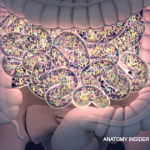Research in type I interferon (IFN) driven mouse models of systemic lupus erythematosus (SLE) suggests the microbiome may play a role in the development of autoimmunity. Additionally, changes in diet may induce protective effects in the gut.1
“Microbes in the gut worsen a lupus model related to the interferon pathway,” says Martin A. Kriegel, MD, PhD, author of a study on the topic in Cell Host & Microbe and adjunct professor of immunobiology at Yale School of Medicine, New Haven, Conn. “We found that the microbiome appears to be a part of this pathway because when you deplete microbes, SLE is ameliorated. We were able to narrow it down to a specific microbe, Lactobacillus reuteri.”
Role of Gut Microbiota
The researchers used both toll-like receptor-7 (TLR7) dependent spontaneous and inducible mouse models. The TLR7 transgenic line shows an 8–16 fold increase in TLR7 expression and spontaneous development of SLE. To induce SLE-like disease, wild-type mice were treated with a TLR7 agonist (topical imiquimod). The researchers then looked at the role of gut microbiota by suppressing growth with broad-spectrum antibiotics or a germ-free state.
Significant changes were seen in survival, decreases in splenomegaly and hepatomegaly, and type 1 IFN gene expression in the ileum, spleen and secretion in the blood. Other indicators, such as plasmacytoid dendritic cells, were suppressed in both models, by antibiotics or a germ-free state. These and other data indicate gut microbiota had an impact on TLR7-dependent autoimmunity.
The researchers defined the microbial community needed for autoimmunity. They collected fecal samples from both spontaneous and induced models. The lupus-prone mice carried different microbial communities than matched wild-type mice. Among these were L. reuteri, Desulfovibrio and Rikenellaceae. However, only Lactobacillus species translocated from the gut, and L. reuteri was dominant. Mice from both models had similar gut microbial community changes, gut leakiness, Lactobacillus species enrichment and translocation to internal organs.
To assess if the gut microbiota is transferable to non-autoimmune mice, the researchers cohoused young TLR7 transgenic mice with wild-type littermates. Fecal testing showed the majority of bacterial taxa enriched in the lupus-prone mice transferred. Included in the transfer were L. reuteri, Desulfovibrio and Rikenellaceae. Cohousing also led to increased gut leakiness and blood IgG levels while decreasing IgA in the stool. TLR7 expression was important because TLR7 knockout mice did not show increased leakiness following cohousing.
Lactobacillus Translocation

Dr. Kriegel
Lactobacillus species were the only microbes to translocate in cohoused wild-type mice. Unlike the lupus models, Lactobacillus johnsonii was the primary species translocated and was limited to mesenteric lymph nodes and the liver.
The researchers next wanted to see if gut microbiota exacerbated systemic autoimmunity. Cecal content was extracted from TLR7 transgenic mice and transferred to wild-type mice before imiquimod treatment. The wild-type mice developed severe splenomegaly, hepatomegaly, enhanced type 1 IFN expression and plasmacytoid dendritic cell accumulation. It increased leakiness and worsened renal disease. This proves that microbiota transferred, translocated outside the gut and exacerbated lupus.
“The microbes in our gut are really too many to deal with,” says Dr. Kriegel. “We, therefore, started with the few that moved beyond the gut barrier. Since we found Lactobacillus inside lymph nodes, [the] liver and spleen, we focused on this microbe.”


